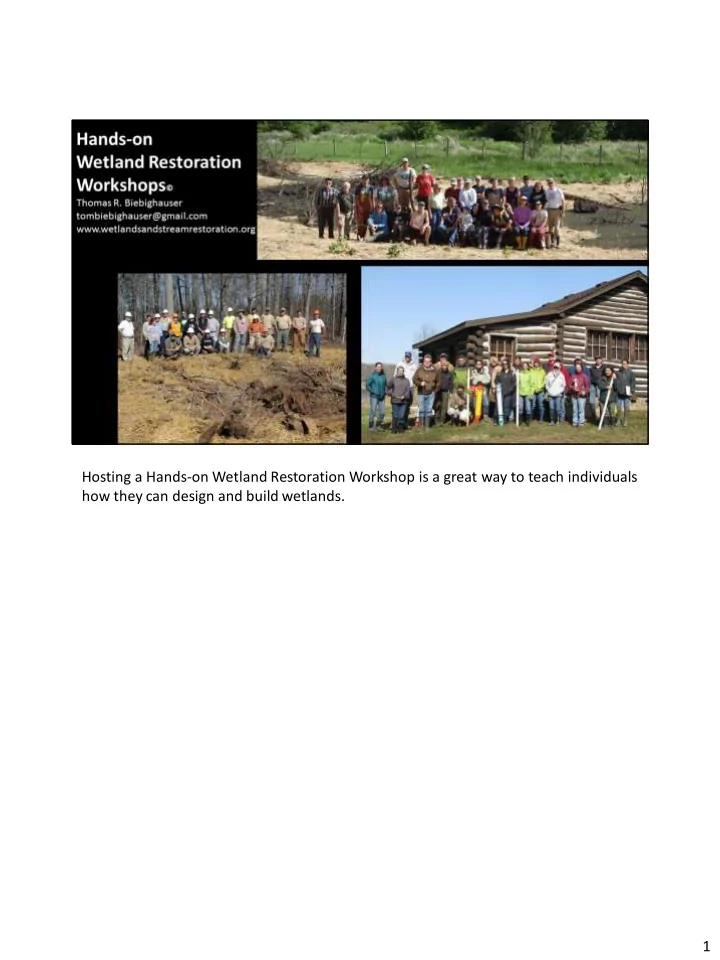

People are introduced to the heavy equipment operator. A detailed safety discussion is held with all of the workshop participants. 54
Heavy equipment is first used to remove vegetation. 55
All observe at a safe distance, yet are close enough to see what is going on. 56
Topsoil is removed and saved for spreading in the finished wetland. 57
Each construction step is explained to the participants. 58
Construction moves fast, with one wetland typically being built from start to finish in less than one day. 59
Here Tom discusses wetland construction with the operator, who has never built a wetland before. The class will be informed with what they discussed after the excavator resumes work. Hands-on Wetland Restoration Workshop train heavy equipment operators, along with the participants. 60
Watching each step the heavy equipment takes to build the wetland is of great interest to those attending. Much like the hosts of a wedding reception, Tom works his way around the site and talks to small groups while construction is taking place. 61
Many find watching the actual construction of a wetland to be better than YouTube. 62
Participants say they learn much from how Tom interacts with the heavy equipment operators who are building the wetland. 63
Discussions are regularly held between Tom, the heavy equipment operator, and the person hosting the Hands-on Wetland Restoration Workshop. A summary of these talks is shared with the participants who are observing construction. 64
The importance of construction monitoring is learned by actually measuring elevations during construction. 65
One becomes familiar with quicksand when building a groundwater wetland! 66
Working alongside the heavy equipment operator boosts self confidence, greatly increasing the chances of a person building a wetland on their own. 67
People find that they don’t have to be an expert to build a wetland. 68
Tom involves workshop participants in lab activities while construction is taking place. Here students are measuring the clay content in soil. 69
Being able to squeeze water from the soil provides a good indication that the soil is both hydric and organic. 70
Mineral soils of various textures are sampled for clay content. 71
Look, this long ribbon shows there’s plenty of clay to build a wetland using the surface water technique! 72
Small wetlands are built in boxes of mud. 73
Students may be tested on their ability to build a wetland in a box. 74
This promises to be a glamorous looking wetland! 75
This wetland has been accepted by wildlife. 76
Each team is asked to explain how they built their wetland. 77
Constructed wetlands are judged by their peers in our own version of the show “Wetland Design Star.” 78
Hand-labor is often needed during construction of the wetland. 79
The wetland is seeded with wheat following heavy equipment operations. Most participants are unaware of the value of wheat for erosion control. 80
Native species of grasses, sedges, rushes, and wildflowers are often sown on the exposed soil surrounding the new wetland. 81
Organics such as wood mulch are raked in when working to remove nitrogen from runoff. 82
Native species of shrubs and trees are often planted by those attending the training. 83
For many it is the first time they have planted a native shrub or tree. 84
This dedicated individual is planting cattails along the perimeter of the new wetland. 85
Live staking is a very effective technique for planting trees and shrubs near wetlands that have a high water table. 86
Adding large woody debris to the wetland can be lots of fun. 87
Returning wood to a wetland can be a team building exercise. 88
Not using a chainsaw to cut stumps is a great way to improve habitat for plants and animals. 89
Branches can be added for salamander egg attachment. 90
Rocks are placed for turtle basking sites. 91
Leaves are added to wetlands for invertebrate production. 92
This new wetland is mulched using straw to control erosion and to reduce the possibility of non-native plants colonizing the site. 93
It is acceptable to dress formal or casual when spreading straw. 94
Mosses that were saved are planted around the new wetland. 95
These transplanted mosses can be expected to do well. 96
Sometimes it is necessary to rock a spillway by hand. 97
These students are proud of the toad house they built. 98
Hands-on Wetland Restoration Workshops show participants how to build forested wetlands like this one constructed in 1992. 99
Or like this one built on a mined area in 2003. 100
Recommend
More recommend